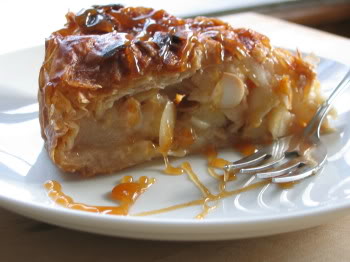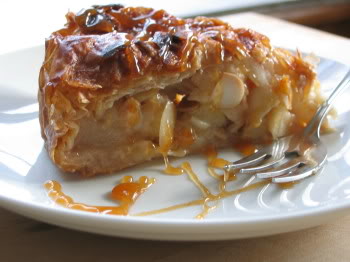
I don’t know about you, but I suck at pie crust. In fact, I pretty much gave up on it after being dumped by a boyfriend who was soooo into pie, at the time I half-believed we broke up over my obvious crustal deficiencies. So when I saw this recipe in the November Gourmet, I tore it out. It’s made with phyllo! After the spanakopita experience a few weeks ago I was eager to try it again. I’ve never made a caramel before, so there was an exciting new twist, too. And most importantly, Thanksgiving was around the corner—so I could make it for my family and not have to deal with S’s dislike of cooked fruit…
On Wednesday morning I woke up really early, and when I finally gave up on falling back to sleep I started peeling apples. The recipe calls for Gala but the farmer’s market supply of that particular variety was terrible, so I substituted something else—winesap, maybe? (Wish I could remember now, cuz it might explain the problems I had with the finished product…) Once the peeling-coring-chunking-tossing-with-lemon-juice-and-cinnamon part was done, it was time to make the caramel. I’ve always been a little afraid of caramels—in all my reading about them it seems like there are a million little things that can go wrong. The directions here—cook butter with honey and sugar in a skillet, stirring constantly with a wooden spoon—were so simple it almost scared me. I figured they’d assumed a certain level of proficiency and left out the important “don’t do X or Y will happen” warnings. But as it turns out, it really was that easy, even if I wasn’t thrilled with the way it tasted, ultimately (more on that later). It foamed and deepened the way they said it would:
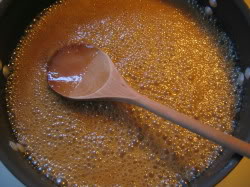
The only tricky part was adding the apples—I had a bit of trouble getting them all stirred in, and if I had cooked them the full ten minutes of the recipe I think it would’ve become applesaucey. Instead I drained them after about seven minutes. Here’s how they looked after being drained and tossed with toasted almonds:
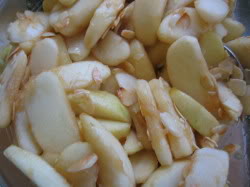
Then it was back to the caramel. Reducing it took quite a bit longer than the recipe said it would—closer to fifteen minutes than the 5-10 stated—but it did look beautiful in the end:
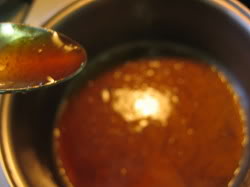
Here’s where the recipe could’ve been written better—it wasn’t clear that the caramel wouldn’t be used in the assembly of the actual dish, so I left it in the pan on the stove. By the time I was done putting the pastis together, it had cooled enough to harden and I had to reheat it just to put it into a storage container.
Next came the fun part—playing with phyllo. It really is very easy, if you’ve got enough counter space to maneuver in (in addition to space to lay out the sheet you’re working on, you have to keep the remaining sheets flat, underneath plastic wrap and a wet kitchen towel). And the best part: I got to use my new stainless steel cake turntable! It was quite useful, in fact, since you have to lay each sheet in a different spot from the one before it, in order to have enough overhang around the whole diameter. Here’s what it looked like when all the phyllo was laid in:
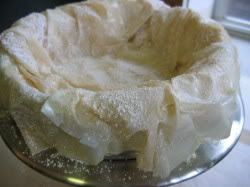
And right before it went into the oven:
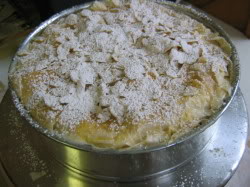
The cooking time was pretty accurate—it said 30-40 minutes at 400, then another 15 at 425. Mine took 30 at 400 & 13 at 425—it would’ve burned if I’d left it longer. Here it is right out of the oven:
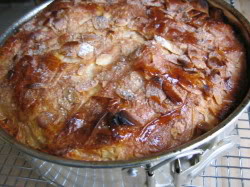
I was a little bit afraid when the time came to take off the springform part, but it didn’t hurt a bit. My pastis was freakin’ gorgeous! I was so proud. A friend came over not long after I set it out to cool and she was just salivating. I beamed like a mama. It was really hard not to just cut into it immediately.
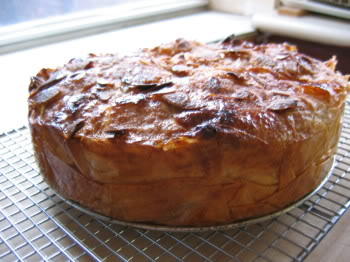
Throughout the day, I kept popping back into the kitchen to visit my masterpiece and revel in its beauty. But by mid-afternoon, I started to notice it was…sinking. One side of it definitely seemed to be collapsing in on itself. I called S in for a second opinion, but we weren’t really sure what it meant. By dinnertime Wednesday we both had to admit there was something funky going on—the sides were almost moist-feeling, and drooping over the edge of the cake pan’s bottom. I was dying to taste it. And then I realized that there were only going to be five of us at Thanksgiving the next day, two of whom are diabetic—I could cut the pastis and only bring half to my parents’.
Two minutes later S and I were drizzling caramel sauce over our slices of pastis (God love him, even though S doesn’t care for cooked fruit, when I make something he’ll always try it). It tasted delicious, simple and nicely sweet and elegant, though the caramel tasted more like honey with a little apple juice mixed in—it was entirely too sweet; the pastis didn’t need it. The toasted almonds were a wonderful crunchy counterpoint, and the top layer of phyllo was flaky and light. The bottom, though, was definitely on its way to being too soggy.
On Thanksgiving morning, it was clear the sogginess had become a real problem. The top of the pastis was starting to go limp. By dinnertime there was no crunch left at all, and the bottom layer was almost disintegrating in wetness. At this point I was grateful that the only victims were my parents and youngest brother—they loved me enough to be forgiving of a less-than-successful effort. In fact, my mother is the type who refuses to acknowledge that a child of hers hasn’t succeeded. She insisted it was wonderful, perfect, even though it wasn’t.
I won’t swear I’ll never make this again since the first day it really did taste great, but it would have to be when I knew I’d be serving it within a few hours. And since that could only happen when I have a bunch of people coming over for dinner or something, when I’d be busily making other things to serve that night, it hardly seems likely. File this one under “Pretty, But Not Practical.”
Hey, did you vote yet? The Pumpkin Bread Pudding is waaaay in the lead, but polls are open until Friday…
